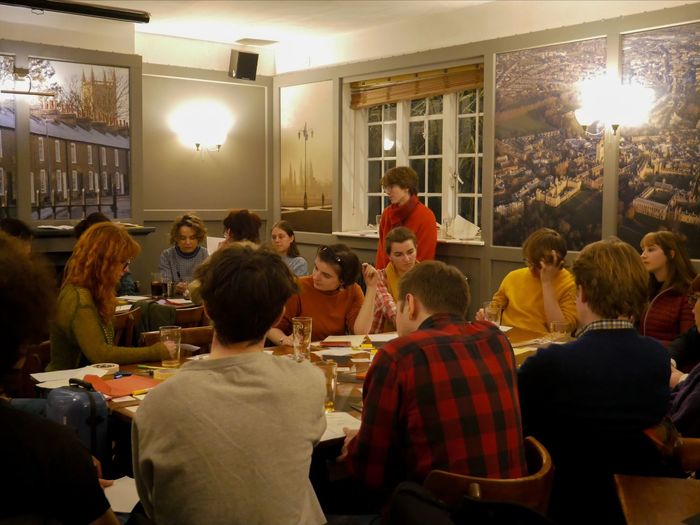A ‘patchwork package’ of skill and creativity: The Mays 32 review
Laila Hussey reviews this year’s collection of new student writing and art, discovering a mosaic of striking work that sticks in the mind and will linger through its legacy

The front cover of this year’s Mays promises, shyly eschewing capital letters, “new writing and art from the students of Oxford and Cambridge” and announces itself to be “guest edited by Lemn Sissay and Denise Riley”. Those exciting yet humbly-rendered assurances aside, the sole figure of Emily Lawson-Todd’s cover illustration peers out. The intricately intentional art by The Mays 32’s own associate editor and illustrator is entirely fitting for the collection it covers. Lawson-Todd’s girl looks out at the reader with a directness belying the confidence and conviction of many of the young artists featured, and the mosaic of her trailing jacket is reminiscent of the patchwork package of this collection. There’s everything in The Mays 32.
“Each piece, long or short, is positioned in a way that allows it to flow naturally from its predecessor”
Bookended by two short, pleasant entries (Tom Zille’s ‘three haiku’ and Felix Armstrong’s ‘Whale poem’), The Mays 32 defies its small size by being packed full. The secret of this year’s success is indeed in its curation. Each piece, long or short, is positioned in a way that allows it to flow naturally from its predecessor while giving it ample room to breathe on its own, allowing the reader to start afresh with each entry. Prose and long-form poetry counterpoint short, snappy vignettes, while the striking visual art breaks up the wordiness.
Credit to the editors for their work in the collation of these pieces is in no way meant to reduce these individual works to mere pieces of a larger puzzle. Each stands out on its own and shows its reason for being selected fairly obviously. Emily Freeman’s ‘Photograph of My Father, c. 1965’ is an undeniably strong follow-up to the editors’ forewords. There is something striking about the way she takes just a kernel, really, and conveys the heaviness and complexity of discovering the mortality of one’s own parents – the bizarreness bordering on offence of seeing these totemic figures as anything other than what they are and always have been to you. In the very same way that Emily located a feeling and a message in a photograph, the reader comes away from her poem with that same sense of realisation.
And yet there are also entries which I couldn’t come away from at all. I’m still at Joe Wright’s entry, at ‘Killhope Cross’. I return to its simple melody again and again, though it deserves none of the malignancy of the term ‘haunting’. It reads like a dream and stays with the reader like a memory. Good writing is often so easy to read that the reader assumes it must have been easy to write. I know better than to think that when writing reads like a cool breeze it’s the product of anything but the sharp skill of the writer behind it.
“It reads like a dream and stays with the reader like a memory”
Just as this is true of the poetic entries of Joe Wright and others, so too is it of the expressive prose included in the collection. Taneesha Datta’s ‘Staying, Leaving’ and Izzy Benardout’s ‘halloumi skewers’, to name just two, are heartfelt and nostalgic without a hint of saccharine. The former is an immersive experience into that halfway place so many multinational people know well. Taneesha writes from within such an experience, giving her entry a vividness that is undeniable, while conveying, too, her sense of alienation, like looking at your own baby photo and recognising nothing of yourself other than the bald, inescapable fact that – unfamiliar though it may be – it is you. Taneesha’s entry, like Izzy’s and so many others, is instructive of the care and craft put into these works.
And despite the supposed lack of a theme connecting these works – as professed by the Editors-in-Chief Famke Veenstra-Ashmore and Leo Kang in their joint foreword – it is this that remains the essence of the collection: the dedication and skill of the student art scene, in its creation, collaboration, and collation. As Lemn Sissay put it: “Writers are hard working”. The Mays 32 is proof.
If it is one great success of The Mays that it fosters new talent as it emerges or matures, it is another success that it does so in a way that connects student creatives, with each generation interacting with and inheriting the dedication of those before them. Just as Sissay wrote in his foreword about meeting Zadie Smith (a former guest editor and contributor herself), and Famke and Leo included their journey from mentor and mentee to co-Editors, The Mays 32 reminds us both of the present talent of Oxbridge creatives and that which it may give way to.
 News / Cambridge study finds students learn better with notes than AI13 December 2025
News / Cambridge study finds students learn better with notes than AI13 December 2025 News / Cambridge Vet School gets lifeline year to stay accredited28 November 2025
News / Cambridge Vet School gets lifeline year to stay accredited28 November 2025 Science / Did your ex trip on King’s Parade? The science behind the ‘ick’12 December 2025
Science / Did your ex trip on King’s Parade? The science behind the ‘ick’12 December 2025 News / Uni Scout and Guide Club affirms trans inclusion 12 December 2025
News / Uni Scout and Guide Club affirms trans inclusion 12 December 2025 Arts / Modern Modernist Centenary: T. S. Eliot13 December 2025
Arts / Modern Modernist Centenary: T. S. Eliot13 December 2025








